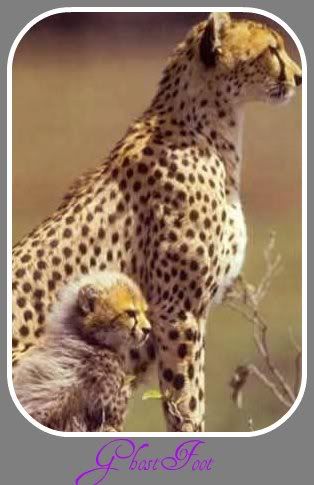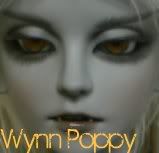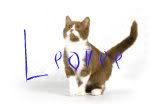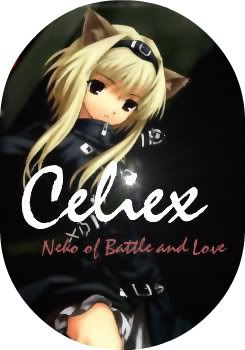Post by GhostFoot on Sept 4, 2010 23:37:17 GMT -5
Curtosey of Chris from warriorcatsrpg.com
THIS IS A VERY LONG LONG LONG LIST. DESCRIPTIVE AND FOOL PROOF. IF YOU STILL HAVE QUESTIONS OR COMMENTS PM ME OR LEAVE A REPLY.
A note for bios:
This guide is just that - you aren't under any obligation in your bio to say 'Lightningpaw is a lilac mink tabby with white and odd eyes' (thought of course if you want to you can!) it's quite okay to say 'she is a grey cat with darer tabby stripes' You don't need to use correct feline colour terminology here, this is just for parties who are interested in them!
The Tabby Patterns

Classic tabby, also known as blotched.
This is a wide striped tabby pattern, often seen swirled or with 'bullseyes'. Modified versions are the marble seen in the Bengal.

Mackerel tabby
A much narrower striped pattern. Usually not swirled like classic tabby.
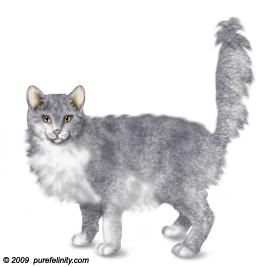
Ticked tabby
Each hair is banded with more than one colour, given an overall 'ticked' appearance. This pattern is seen in the Abyssinian and Somali breeds.

Spotted tabby.
Fairly self-explanatory! Some striping can usually still be seen around the tail, legs, face, and shoulders.
The modified version is a rosetted cat, such as the Bengal breed.
The Colours
Most colours as easily classed into solids (not tabby) Tabby (striped) or bicoloured (with white). I'll start with the basics then go into some more colours such as tortoiseshells and colourpoints!
Black
Sometimes bares faint striping, which is usually only visible in good light.
A black cat with white markings can be called a black with white or a black and white bicolour. But a black with white markings on the belly, paws, and face is often called a tuxedo, a term for this specific colour pattern.
Solid Black

Tuxedo

Blue
The dilute form of black is blue. A lot of people simply call this 'grey', although blue is the technical term for the colour. The tabby blue is grey with darker grey stripes.
Solid blue
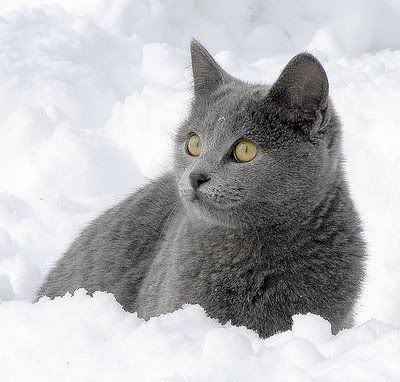
Solid blue and white
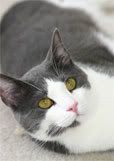
Blue tabby (classic)
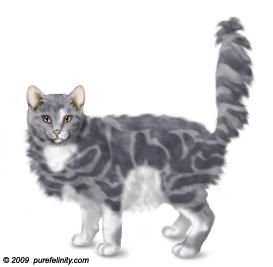
Blue tabby and white.

Brown Tabby
Brown is seen only in a tabby form, although there are brown-coloured shades, they have specific names like cinnamon or chocolate. Brown in itself is usually seen as a brown tabby. The base can be varying shades of brown, with black stripes.
There is also a variant of brown tabby which is the true golden tabby. The term 'golden tabby' is often used to describe two coat colours - a red tabby, which often has a golden hue, and the true 'brown tabby' golden tabby.
Brown tabby (mackerel)
Brown tabby with white. (mackerel)
Golden tabby with white (brown tabby variant)
Red Tabby
Red is an interesting colour - it doesn't have a solid version. Even reds that look solid show a few stripes around the face or legs.
Red is also commonly called ginger in cats.
The base colour is orange-red to gold, with stripes a shade darker.
Red tabby (classic)
Red tabby and white
Notice how this red tabby's fur has a golden tint in the outdoor light - you can see why many red tabbys are referred to as 'gold' in a photo like this.
Cream Tabby
Cream is the dilute version of red, and as such the same striping rules apply, although they can be hard to see on a pale cream.
Cream tabby
Cream tabby and white
Chocolate
Chocolate is a rich, warm brown shade. Can be solid or tabby.
Chocolate solid pair of cats.
Solid chocolate and white
Chocolate tabby (classic)
Lilac
Lilac can be a hard colour to pick. It is a greyish shade, but warmer, often described as dove grey.
Solid lilac
Solid lilac and white
Lilac tabby (classic)
Cinnamon
Cinnamon is a light brown with a reddish tone. A rare colour.
Solid cinnamon
Solid cinnamon and white
Cinnamon tabby (classic)
Cinnamon tabby with white (classic)
Fawn
Fawn is the dilute of Cinnamon. It is a rare colour. A pale warm greyish creamy shade.
Solid fawn
Solid fawn with white
Fawn tabby (spotted)
White
Fairly self explanatory... white cats are all white! White 'masks' the genetic colour underneath.
An odd-eyed white.
Amber
Amber is one of the rarest colours. A reddish toned apricot colour.
Amber tabby.
Tortoiseshell
This is a combination of two colours, most often red and black. Torties confuse many people because there are so many different types - you can get many different colours combined in a tortie, they can have white markings, and they can be any of the tabby patterns, making them a wide array of colours and patterns.
They are usually female, due to needing two X genes to express. (Males only have one X gene).
Tortoiseshell and white is usually applied to a tortie with a few white markings.
Calico is a term used for a cat who is half white or more, with tortoiseshell patches.
Torbie is a term for a tortoiseshell with tabby patches, instead of solid colour patches.
Due to red and cream always showing some striping, it can be hard to tell some torbies and torties apart. To find out if a cat has solid or tabby patches, look at the non red/cream colour!
Tortoiseshell
Tortoiseshell and white
Calico - mainly white with a few tortoiseshell patches
Torbie - brown tabby and red tabby patches. This torbie is odd-eyed.
Torbie and white
Blue Tortoiseshell and white
Blue torbie with white.
Chocolate tortoiseshell
Chocolate calico
Chocolate torbie
Lilac tortie and white
Cinnamon tortie and white
Cinnamon torbie
Fawn Torbie (spotted)
Fawn Tortie and white
Silver torbie and white
Silver Tabby
Silver Tabby is another colour only seen in a tabby form. The solid versions of silver tabby are actually smokes, see the section below.
A silver tabby has a white basecoat and black striping. They look silver-grey base with black. Sometimes confused with blue tabbies. Blue tabbies always have grey stripes, whereas silver tabbies have black.
Silver tabby (Classic)
Silver tabby with white (mackerel)
Smoke
Smoke is the silver tabby version of solid colours. It is a white undercoat, visible when the coat is parted, or when the cat is walking. Sometimes they have a paler ruff. It can affect any solid colour. They can have white markings. They can come in tortoiseshell form.
Black smoke
Black smoke and white
Blue smoke
Blue smoke and white
Chocolate smoke
Cinnamon smoke
Fawn smoke
Tortie and white smoke
Chocolate tortie smoke
Silvers
Silver can affect other coloured tabby patterns as well. They lighten up the base coat, while leaving the colour of the striping intact. They are generally known as 'silvers' combined with the colour of coat- red silver, blue silver, ect.
Red silvers and sometimes cream silvers are often called cameo.
Blue silver tabby (Classic)
Red silver tabby (Classic)
Cream silver tabby with white. (Classic)
Chocolate silver tabby (classic)
Lilac silver (classic)
Cinnamon silver tabby - this is a really excellent example, a nice clear silvery undercoat with well defined stripes (classic)
Fawn silver tabby (spotted)
Amber silver tabby.
Pointed Colours
Pointed cats have a light body colour and darker coloured 'points - the face, ears, legs, and tail. They always have blue eyes, and are always born white and develop colour with age. They can have white markings.
There are solid versions (no striping) and tabby versions, which are called lynx.
Seal point (black pointed - is actually a very dark brown to look at)
Brown Lynx point (brown tabby in point form)
Blue point
Blue point and white
Blue lynx point
Blue lynx point and white
Red point (also called flame point)
Red point and white
Cream point
Cream point and white
Chocolate point
Chocolate point and white
Chocolate lynx point
Lilac point
Lilac point and white
Cinnamon point
Cinnamon lynx point
Fawn lynx point
Pointed - Tortoiseshell
All the tortoiseshell colours are available in pointed form - whew, that's a lot of variation!
Tortoiseshell point
Blue tortoiseshell Point, and white
Lilac tortie point
Cinnamon tortoiseshell Point
Sable
Seen in the Burmese breed. This is a subtle colouring related to colourpoints. The body colour is lightened, but usually remains the same general tone.
They can have white markings, but as Burmese are not bred to have white markings, you usually only get white-marked sables when cross breeding.
Brown sable
Blue sable
Red sable
Cream sable
Chocolate sable
Lilac sable
Cinnamon sable
Fawn sable
Blue tortoiseshell sable
Chocolate tortoiseshell sable
Lilac tortoiseshell sable
Mink
Minks occur when a cat inherits one colourpoint gene and one sable gene. Mink is an intermediate between the two colours, with a lighter body and darker limbs, ears and face. They are darker than colourpoints but not quite as dark as sables.
Mink seal and white
Mink blue
Mink blue and white
Mink red and white
Mink chocolate
Mink lilac
Mink lilac and white
Mink tortoiseshell and white
Mink blue tortoiseshell and white
Shaded
Also called tipped, shell, or chinchilla. A silver colouring. Shaded is a subtle scattering of colour restricted to the tips of the hairs giving an overall white body appearance, with slight tinge of colour.
Shaded silver
Shaded cream
THIS IS A VERY LONG LONG LONG LIST. DESCRIPTIVE AND FOOL PROOF. IF YOU STILL HAVE QUESTIONS OR COMMENTS PM ME OR LEAVE A REPLY.
A note for bios:
This guide is just that - you aren't under any obligation in your bio to say 'Lightningpaw is a lilac mink tabby with white and odd eyes' (thought of course if you want to you can!) it's quite okay to say 'she is a grey cat with darer tabby stripes' You don't need to use correct feline colour terminology here, this is just for parties who are interested in them!
The Tabby Patterns

Classic tabby, also known as blotched.
This is a wide striped tabby pattern, often seen swirled or with 'bullseyes'. Modified versions are the marble seen in the Bengal.

Mackerel tabby
A much narrower striped pattern. Usually not swirled like classic tabby.

Ticked tabby
Each hair is banded with more than one colour, given an overall 'ticked' appearance. This pattern is seen in the Abyssinian and Somali breeds.

Spotted tabby.
Fairly self-explanatory! Some striping can usually still be seen around the tail, legs, face, and shoulders.
The modified version is a rosetted cat, such as the Bengal breed.
The Colours
Most colours as easily classed into solids (not tabby) Tabby (striped) or bicoloured (with white). I'll start with the basics then go into some more colours such as tortoiseshells and colourpoints!
Black
Sometimes bares faint striping, which is usually only visible in good light.
A black cat with white markings can be called a black with white or a black and white bicolour. But a black with white markings on the belly, paws, and face is often called a tuxedo, a term for this specific colour pattern.
Solid Black

Tuxedo

Blue
The dilute form of black is blue. A lot of people simply call this 'grey', although blue is the technical term for the colour. The tabby blue is grey with darker grey stripes.
Solid blue

Solid blue and white

Blue tabby (classic)

Blue tabby and white.

Brown Tabby
Brown is seen only in a tabby form, although there are brown-coloured shades, they have specific names like cinnamon or chocolate. Brown in itself is usually seen as a brown tabby. The base can be varying shades of brown, with black stripes.
There is also a variant of brown tabby which is the true golden tabby. The term 'golden tabby' is often used to describe two coat colours - a red tabby, which often has a golden hue, and the true 'brown tabby' golden tabby.
Brown tabby (mackerel)
Brown tabby with white. (mackerel)
Golden tabby with white (brown tabby variant)
Red Tabby
Red is an interesting colour - it doesn't have a solid version. Even reds that look solid show a few stripes around the face or legs.
Red is also commonly called ginger in cats.
The base colour is orange-red to gold, with stripes a shade darker.
Red tabby (classic)
Red tabby and white
Notice how this red tabby's fur has a golden tint in the outdoor light - you can see why many red tabbys are referred to as 'gold' in a photo like this.
Cream Tabby
Cream is the dilute version of red, and as such the same striping rules apply, although they can be hard to see on a pale cream.
Cream tabby
Cream tabby and white
Chocolate
Chocolate is a rich, warm brown shade. Can be solid or tabby.
Chocolate solid pair of cats.
Solid chocolate and white
Chocolate tabby (classic)
Lilac
Lilac can be a hard colour to pick. It is a greyish shade, but warmer, often described as dove grey.
Solid lilac
Solid lilac and white
Lilac tabby (classic)
Cinnamon
Cinnamon is a light brown with a reddish tone. A rare colour.
Solid cinnamon
Solid cinnamon and white
Cinnamon tabby (classic)
Cinnamon tabby with white (classic)
Fawn
Fawn is the dilute of Cinnamon. It is a rare colour. A pale warm greyish creamy shade.
Solid fawn
Solid fawn with white
Fawn tabby (spotted)
White
Fairly self explanatory... white cats are all white! White 'masks' the genetic colour underneath.
An odd-eyed white.
Amber
Amber is one of the rarest colours. A reddish toned apricot colour.
Amber tabby.
Tortoiseshell
This is a combination of two colours, most often red and black. Torties confuse many people because there are so many different types - you can get many different colours combined in a tortie, they can have white markings, and they can be any of the tabby patterns, making them a wide array of colours and patterns.
They are usually female, due to needing two X genes to express. (Males only have one X gene).
Tortoiseshell and white is usually applied to a tortie with a few white markings.
Calico is a term used for a cat who is half white or more, with tortoiseshell patches.
Torbie is a term for a tortoiseshell with tabby patches, instead of solid colour patches.
Due to red and cream always showing some striping, it can be hard to tell some torbies and torties apart. To find out if a cat has solid or tabby patches, look at the non red/cream colour!
Tortoiseshell
Tortoiseshell and white
Calico - mainly white with a few tortoiseshell patches
Torbie - brown tabby and red tabby patches. This torbie is odd-eyed.
Torbie and white
Blue Tortoiseshell and white
Blue torbie with white.
Chocolate tortoiseshell
Chocolate calico
Chocolate torbie
Lilac tortie and white
Cinnamon tortie and white
Cinnamon torbie
Fawn Torbie (spotted)
Fawn Tortie and white
Silver torbie and white
Silver Tabby
Silver Tabby is another colour only seen in a tabby form. The solid versions of silver tabby are actually smokes, see the section below.
A silver tabby has a white basecoat and black striping. They look silver-grey base with black. Sometimes confused with blue tabbies. Blue tabbies always have grey stripes, whereas silver tabbies have black.
Silver tabby (Classic)
Silver tabby with white (mackerel)
Smoke
Smoke is the silver tabby version of solid colours. It is a white undercoat, visible when the coat is parted, or when the cat is walking. Sometimes they have a paler ruff. It can affect any solid colour. They can have white markings. They can come in tortoiseshell form.
Black smoke
Black smoke and white
Blue smoke
Blue smoke and white
Chocolate smoke
Cinnamon smoke
Fawn smoke
Tortie and white smoke
Chocolate tortie smoke
Silvers
Silver can affect other coloured tabby patterns as well. They lighten up the base coat, while leaving the colour of the striping intact. They are generally known as 'silvers' combined with the colour of coat- red silver, blue silver, ect.
Red silvers and sometimes cream silvers are often called cameo.
Blue silver tabby (Classic)
Red silver tabby (Classic)
Cream silver tabby with white. (Classic)
Chocolate silver tabby (classic)
Lilac silver (classic)
Cinnamon silver tabby - this is a really excellent example, a nice clear silvery undercoat with well defined stripes (classic)
Fawn silver tabby (spotted)
Amber silver tabby.
Pointed Colours
Pointed cats have a light body colour and darker coloured 'points - the face, ears, legs, and tail. They always have blue eyes, and are always born white and develop colour with age. They can have white markings.
There are solid versions (no striping) and tabby versions, which are called lynx.
Seal point (black pointed - is actually a very dark brown to look at)
Brown Lynx point (brown tabby in point form)
Blue point
Blue point and white
Blue lynx point
Blue lynx point and white
Red point (also called flame point)
Red point and white
Cream point
Cream point and white
Chocolate point
Chocolate point and white
Chocolate lynx point
Lilac point
Lilac point and white
Cinnamon point
Cinnamon lynx point
Fawn lynx point
Pointed - Tortoiseshell
All the tortoiseshell colours are available in pointed form - whew, that's a lot of variation!
Tortoiseshell point
Blue tortoiseshell Point, and white
Lilac tortie point
Cinnamon tortoiseshell Point
Sable
Seen in the Burmese breed. This is a subtle colouring related to colourpoints. The body colour is lightened, but usually remains the same general tone.
They can have white markings, but as Burmese are not bred to have white markings, you usually only get white-marked sables when cross breeding.
Brown sable
Blue sable
Red sable
Cream sable
Chocolate sable
Lilac sable
Cinnamon sable
Fawn sable
Blue tortoiseshell sable
Chocolate tortoiseshell sable
Lilac tortoiseshell sable
Mink
Minks occur when a cat inherits one colourpoint gene and one sable gene. Mink is an intermediate between the two colours, with a lighter body and darker limbs, ears and face. They are darker than colourpoints but not quite as dark as sables.
Mink seal and white
Mink blue
Mink blue and white
Mink red and white
Mink chocolate
Mink lilac
Mink lilac and white
Mink tortoiseshell and white
Mink blue tortoiseshell and white
Shaded
Also called tipped, shell, or chinchilla. A silver colouring. Shaded is a subtle scattering of colour restricted to the tips of the hairs giving an overall white body appearance, with slight tinge of colour.
Shaded silver
Shaded cream

